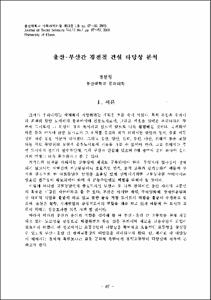암성흉수의 진단에 있어서 Flow cytometry를 이용한 DNA Ploidy 측정의 역할
- Alternative Title
- The Role of DNA Analysis using Flow Cytometry in the Diagnosis of Malignant Pleural Effusion
- Abstract
- 연구배경 : 암성 흉수는 한국에서 흔한 결핵성 흉수와 마찬가지로 흉수내에 림프구를 주로 보이나, 일반 생화학 검사나 흉수 세포 진단법 및 흉막 조직 검사상에도 특이적 소견이 나타나지 않는 경우가 흔하여 감병진단에 어려움이 있다. 최근 악성 종양에서 염색체이상에 따르는 DNA 양적이상이 보고되었으며 Flow cytometry는 세포들의 주기 분석 및 DNA양의 분석이 가능하며 조작이 ?F灼構? 신속히 수행할 수 있는 객관적인 검사방법으로 인정되고 있다. 이에 저자들은 림프구를 주로 보이는 흉수에서 Flow cytometry를 이용한 DNA 양적 이상의 측정이 암성 흉수의 감별 진단에 도움을 줄 수 있는지 여부를 조사하기 위하여 다음과 같은 연구를 시행하였다.
방법 : 흉수 세포 진단법 및 흉박 조직 검사상 확진된 결핵성 흉막염 환자 14명과 암성 흉막염환자 21명의 흉수를 99% 에탄올로 고정시키고 popidiumiodide로 DNA를 염색한후 Flow cytometry를 이용하여 이수배수체의 여부와 합성기의 세포 분포율을 조사하였다.
결과 : 결핵성 흉막염군의 흉수 분석 결과 14예 모두 두배수체를 보였다. 암성 흉막염군의 경우 총 21예중 10예에서 이수배수체를 보였고 11예는 두배수체를 보였다. 합성기(S기)의 분포를 비교한 결과 결핵성 흉박염군의 평균 합성기 분포는 3.72±1.06%, 암성 흉막염군의 평균 합성기 분포는 6.69±1.79%로 두군간에 통계적으로 유익한 차이가 없었다.(p=0.1152). DNA 이수배수체제에 의한 암성흉수진단의 민감도는 47.6%, 특이도는 100%이었다.
결론 : 삼출액이면서 림프구를 주로 보이는 흉수 환자에서 flow cytometry를 이용한 DNA 분석상 이수배수체를 보일 때 암성 흉수의 가능성이 높으므로 세포 진단법이나 흉막 생검상 비특이적 소견이 보이더라도 확진을 위한 적극적인 노력이 필요한 것으로 사료된다.
Backround There are some difficulties in the differential diagnosis of lymphocyte-dominant exudative pleural effusion because of nonspecific chemocal findings and poor positive yield of cytopathologic findings. It has been known that most malignant tumor cells possess an abnormal number of chromosome and consequently an abnormal DNA content. Flow cytomery allows rapid and accurate analysis of DNA contents. Therefore the detection of aneuploidy in pleural fluid using flow cytometry could be used for the differential diagnosis between malignant and benign effusion.
Methods Flow cytometric DNA analysis were perfomed in 14 tuberculous pleural effusions and 21 malignant effusions, which were confirmed by cytopathological method. Samples were fixed in absolute ethanol and stained with propidium iodide, a DNA intercalating fluorescent stain.
Results All of the 14 tuberculous effusions showed diploidy. Among the 21 malignant effusions, 10 samples had aneuploidy. The comparison of S-phase fraction, the indicator of cellular proliferative activity, showed no significant difference between tuberculous and malignant effusions. Flow cytometric analysis, compared to cytopathology, yields 46.7% sensitivity, 100% specificity.
Conclusion The finding of aneuploidy in pleural fluid highly suggest malignancy in etiology. Therefore if flow cytometric DNA analysis show aneploidy, further diagnostic work up would be required.
Backround There are some difficulties in the differential diagnosis of lymphocyte-dominant exudative pleural effusion because of nonspecific chemocal findings and poor positive yield of cytopathologic findings. It has been known that most malignant tumor cells possess an abnormal number of chromosome and consequently an abnormal DNA content. Flow cytomery allows rapid and accurate analysis of DNA contents. Therefore the detection of aneuploidy in pleural fluid using flow cytometry could be used for the differential diagnosis between malignant and benign effusion.
Methods Flow cytometric DNA analysis were perfomed in 14 tuberculous pleural effusions and 21 malignant effusions, which were confirmed by cytopathological method. Samples were fixed in absolute ethanol and stained with propidium iodide, a DNA intercalating fluorescent stain.
Results All of the 14 tuberculous effusions showed diploidy. Among the 21 malignant effusions, 10 samples had aneuploidy. The comparison of S-phase fraction, the indicator of cellular proliferative activity, showed no significant difference between tuberculous and malignant effusions. Flow cytometric analysis, compared to cytopathology, yields 46.7% sensitivity, 100% specificity.
Conclusion The finding of aneuploidy in pleural fluid highly suggest malignancy in etiology. Therefore if flow cytometric DNA analysis show aneploidy, further diagnostic work up would be required.
- Issued Date
- 1995
- Type
- Research Laboratory
- Alternative Author(s)
- Kim, Woo Sung; Koh, Younsuck; Choi, Jeong Eun; Kim, Dong Soon; Kim, Won Dong; Lee, Sang Do; Lim, Chae Man; Chi, Hyun Sook
- Publisher
- 울산의대학술지
- Language
- kor
- Rights
- 울산대학교 저작물은 저작권에 의해 보호받습니다.
- Citation Volume
- 4
- Citation Number
- 1
- Citation Start Page
- 44
- Citation End Page
- 49
- Appears in Collections:
- Research Laboratory > The ULSAN university medical journal
- 파일 목록
-
-
Download
 000002024504.pdf
기타 데이터 / 884 kB / Adobe PDF
000002024504.pdf
기타 데이터 / 884 kB / Adobe PDF
-
Items in Repository are protected by copyright, with all rights reserved, unless otherwise indicated.